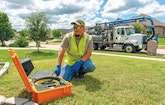
Wastewater technician Bryce Skotnicki (left) and crew lead Leston Dhane log the condition and cleanliness of a sewer main prior to cleaning. This is the department’s policy every time a manhole cover is opened.
To say that Princeton, Texas, is growing is something of an understatement.
The city’s population is on track to top 16,500 people by 2020 — 2 1/2 times the 2010 census count of 6,800. And the trend shows no sign of ending soon.
Princeton’s population explosion has been...








